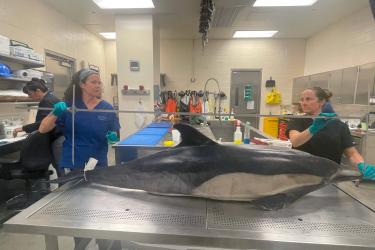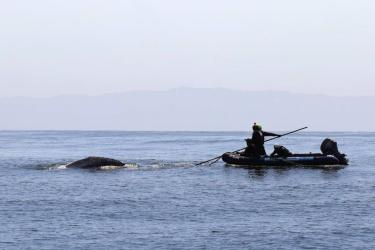Endangered Species Act-listed species of salmon and trout, including the Upper Willamette River Chinook and steelhead, migrate through Oregon's most populated areas on their way to spawning grounds. Their safe passage through urban waterways is key to their survival.
Over the next 3 years, the Clackamas Partnership is removing barriers and restoring habitat at 10 sites around the Portland Metro area. NOAA’s Office of Habitat Conservation awarded $3.8 million to the partnership under the Bipartisan Infrastructure Law and Inflation Reduction Act.
“Getting the NOAA funding has been critical in scaling up our impact,” says Daniel Newberry, Director of Johnson Creek Watershed Council, a member of the partnership. “We think we're going to have a really measurable benefit to listed fish in this area.”
Many of the projects involve creating or restoring habitat for juvenile fish, which spend a year or more eating and growing in fresh water before heading out to the ocean. The bigger and stronger juveniles grow in streams, the better their chances of survival at sea.
“Tributaries of the Willamette River, like the Clackamas River and Johnson Creek, have pretty rapid flows in the winter and spring and juvenile fish need calm, cool side channels to pull over and eat and grow and not get eaten,” says Lauren Senkyr, Marine Habitat Resource Specialist for NOAA. “Unfortunately many of the side channels have been lost over time due to development.”
In addition to helping fish, some projects will also protect community members from flood risks. “One of the fish passage barriers that will be replaced—a culvert—runs under the only access road for a couple of residents in the area,” says Senkyr. “If the culvert is blocked during high winter flows, the road could wash out and cut off those residents from emergency services.”
With much of the work occurring near urban areas, project partners are making a major effort to engage the community in the restoration process. “We are creating videos of each of the 10 projects so we can show people what restoration really means,” says Newberry. “Because there is a significant Spanish-speaking population in our area, we contracted with a Latino-owned business to produce the videos in both English and Spanish.”
“This award is touching diverse populations—including tribal members—and providing jobs, internships, and educational opportunities to community members,” says Newberry. “The educational programs in particular are helping to create a stewardship ethic among the young people. They're showing people ways, big and small, that they can make a difference in their watershed.”
The project partners are also planning to sponsor river rafting trips that will stop at restoration sites. These trips will help young people from underserved communities learn about river restoration in a fun way.
“In a lot of urban areas in Oregon, people think of salmon as something that exists up in Alaska or some other very pristine environment,” says Newberry. “They are surprised but really excited when we tell them there’s salmon in their watershed. It really spurs people to learn more about salmon ecology and about the importance of restoring fish.”
NOAA’s Office of Habitat Conservation is reinvigorating efforts to restore threatened salmon and trout species in Oregon’s Willamette River watershed. This is one of four restoration projects being funded under the Bipartisan Infrastructure Law and Inflation Reduction Act.




